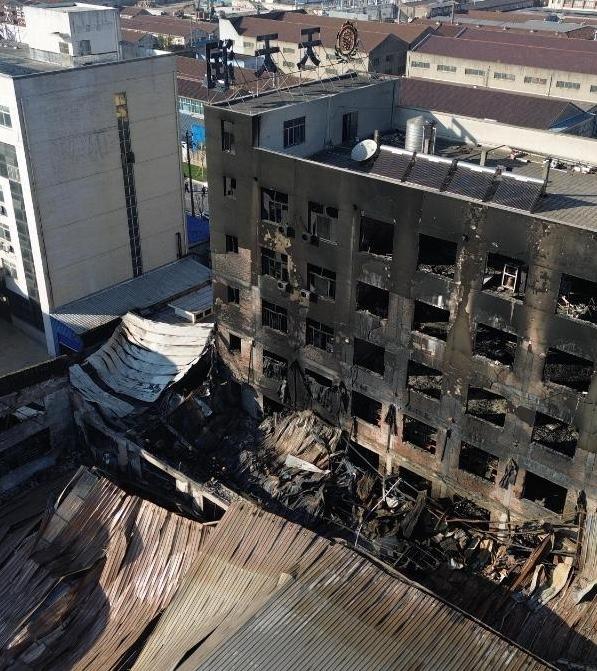
Photograph: humphery / Shutterstock.com
Letter from the Editors
Season’s greetings from all of us at China Labour Bulletin.
Since our last newsletter, we have been focusing on the topic of workplace safety in the context of factory fires in China.
It’s a tragic pattern that the accidents we are analysing have all occurred in November: the 1993 Zhili Toy Factory fire that killed 87, the 2022 fire in Anyang that killed 42 garment factory workers, and just last month, the fire at the Tiantianrun textile factory in Wuxi that killed seven.
The majority of those who have lost their lives in these three cases have been female migrant workers, and the contributing causes of the fires have been similar and preventable. For the victims, survivors, and their families, justice has been neither swift nor sure.
Thanks for reading!
CLB Editors
Worker Voices

On the evening of 20 November 2023, a fire broke out on the first floor of a textile factory in Wuxi, Jiangsu province, killing seven workers on the fourth floor of the five-storey building. All seven workers who lost their lives were women migrant workers from Guizhou and Shandong provinces.
They were employed at the building owned by Wuxi Tiantianrun Textile & Technology Co. Ltd., which produces fancy yarns for the international market. The fourth floor where they worked was rented out to another corporate entity that CLB has not been able to verify.
Tiantianrun is one of the major fancy yarns manufacturers in China and supplies to notable brands including Lion Brand Yarn (U.S.) and to retailers, including TEDi (Germany), Action (Netherlands), and Hema (Netherlands).
CLB compared the circumstances of Tiantianrun fire to last year’s deadliest workplace accident, the fire in Anyang, Henan province, that killed a few dozen garment factory workers. In that case, a woman in her 50s relayed to domestic media the story of her escape from the fire.
She told reporters that a fire exit on one side of the building was blocked on the ground floor by a wall surrounding the factory site, so she asked her husband to hurry and bring a ladder. By the time he arrived, she and twenty others had managed to escape.
A reporter asked if she would go back to work in a garment factory again, and she said she would:
We still have to earn money. We don’t have much education. We can’t do anything else. I can only say that from now on, we will pay more attention to safety.
Worker Representation

Although the official investigation report of the Tiantianrun factory fire will likely not be available for several months, the characteristics of this incident seem to follow patterns of well-known safety risks in the industry.
The similarities to both the November 2022 fire in Anyang and the 1993 Zhili Toy Factory fire are striking:
- The practice of crowding warehouse space and factory space in the same building presents dangers to workers when flammable materials are not properly stored;
- Property owners who lease out parts of their buildings to multiple corporate tenants without following safety regulations also contribute to fire hazards among different enterprises;
- A lack of safety protocol and safety equipment is another common feature of manufacturing accidents that take workers’ lives.
The role of frontline workers in identifying and raising safety hazards in the normal course of their work should become a priority, in line with provisions in China’s Work Safety Law. Implementing such a mechanism would go a long way in preventing workplace accidents in China. To do this would require trade union officials to regularly interact with workers and represent them before their employers to urge for safer working conditions before problems arise.
International actors with supply chains in China should ensure they understand and take steps to ameliorate the safety risks systemic in China’s manufacturing industry, that workers in their supply chains are guaranteed the freedom of association and adequate representation under China’s Trade Union Law, and that workers and their families affected by workplace accidents are compensated according to domestic laws and humanitarian principles.
Strike Action

Increase in strikes and protests last month. In November 2023, the CLB Strike Map recorded 241 worker strikes and protests, an increase from the previous month. The construction industry, as usual, saw the most worker actions, with 132 incidents logged. Collective actions in the manufacturing and service industries increased compared to October, increasing from 43 to 57 and from 19 to 27, respectively. Among the manufacturing incidents, the most notable increase was from the garment and apparel industry (16 incidents). These are concentrated in Jiangsu, Guangdong, Fujian, and Zhejiang provinces, with workers protesting over wage arrears and relocation of traditional textile and shoe factories.
Textile and shoe factory workers go on strike. Hundreds of workers went on strike at the Taiwan-owned Baoyi Shoe Manufacturing Co. Ltd. in Yangzhou, Jiangsu province, after the company announced its relocation in late November. Workers demanded the factory pay compensation and correct arrears of social security, bonuses and other payments. Another Taiwan-owned company, De Licacy Industrial Co. Ltd. in Hangzhou, announced its relocation at the beginning of November, and police formed a human chain (see photo above) to respond to the strike. CLB interviewed local government departments and trade unions relevant to these two cases and found that the companies’ enterprise unions were not functioning adequately before the factory shutdowns. Workers were not informed of the companies’ decisions, and their interests were not represented or protected by unions. After the strikes, workers at both factories said online they were able to get their legal compensation, but China’s labour laws could have been better enforced before workers’ rights were violated.
Online ride-hailing drivers protest new energy vehicle pilot programs. In Chengdu, workers gathered in front of an online ride-hailing company on 22 November and asked the company to explain why they had been remotely locked out of their cars. In 2021, 11 cities were included in a pilot program to swap batteries in new energy vehicles, but drivers are unwilling to bear the increased cost of the batteries when their new energy vehicles are operating normally. The platform remotely locked these drivers out of their vehicles for not complying. One driver said that the price of switching batteries is much higher than that of electric vehicle charging, and it is not convenient. The electricity at the Chengdu battery swapping station amounts to a daily cost increase of about 50 yuan.
CLB in the News

CLB’s Strike Map data on the manufacturing industry was cited by Business of Fashion and McKinsey & Company in an annual forecast of global supply chain pressures.
In China, the world’s largest textile producer, the number of worker strikes and protests rose in 2023. According to the China Labour Bulletin, more than 700 factory strikes in the first half of 2023 took place, compared to 800 in all of 2022.
The article describes the “bullwhip” effect of changing consumer demands broadly affecting supply chains, and provides recommendations to brands, including transparency and communication among all stakeholders in the supply chain, and that brands “continue to actively champion workers’ rights.” The article states that this championing encompasses “ensuring fair wages, job protection, safe working conditions and opportunities for professional development for factory workers.”
CLB in Action

Recently, while on a visit in Europe, CLB’s Executive Director Han Dongfang spoke with Bread for the World in Germany about how new due diligence legislation in Europe can support workers and worker organizing in Asia:
[We need] international collaboration and support during implementation [of the laws]. On the one hand, international campaigns will not create long lasting solutions, if they are not embedded in specific workplace negotiations in the Global South. On the other hand, while our union is bargaining with an employer, it is important for union representatives and members to know that one or two specific organisations in the Global North are backing us up. In the long term, successful use of supply chain laws is likely to result in higher numbers of trade union members, strengthened bargaining position of unions and higher chances for better collective bargaining agreements. As a result, more unions in the Global South are capable of standing on our own feet, and gradually, more responsible global supply chains are achieved through workers’ participation via union-management negotiation.
While abroad, Han also participated in the annual event (see photo above) organised by the Swedish National Secretariat for Sustainable Public Procurement (Hållbar Upphandling). Han spoke on how CLB uses online tools as a new way of monitoring workplaces and supporting workers when conducting traditional on-site monitoring and engagement is impossible.
CLB Insights
What could the new pilot free trade zone plan in Shanghai mean for labour rights protections?
This year’s rise in strikes and protests in China’s manufacturing sector has coincided with foreign production shifting to Southeast Asia, trade tensions between the U.S. and China, and technological changes that displace human workers. At the same time, China has been actively trying to calm and attract investors, especially those whose businesses involve artificial intelligence technology, medical equipment, pharmaceutical research, and autonomous driving.
One tactic is to enhance legal frameworks to promote investment. Among the targeted changes China has recently put forward is the improvement of labour rights protections for workers.
On 7 December 2023, the State Council released a new set of measures regarding the free trade zones in Shanghai. The new plan is entitled, “Advancing the Overall Plan for High-level Institutional Opening-up in the China (Shanghai) Pilot Free Trade Zone” (Overall Plan).
The Overall Plan includes provisions to improve international business conditions such as those on trade liberalisation, digital technology and intellectual property, among others. Through this Overall Plan, the government also indicates that more comprehensive and effective labour protection mechanisms will be beneficial to these companies.
Indeed, improved labour rights are not at odds with economic development. Further, these measures to be piloted in Shanghai provide an opportunity for international and regional laws and standards on labour rights in supply chains to take better root in China in the near term.
